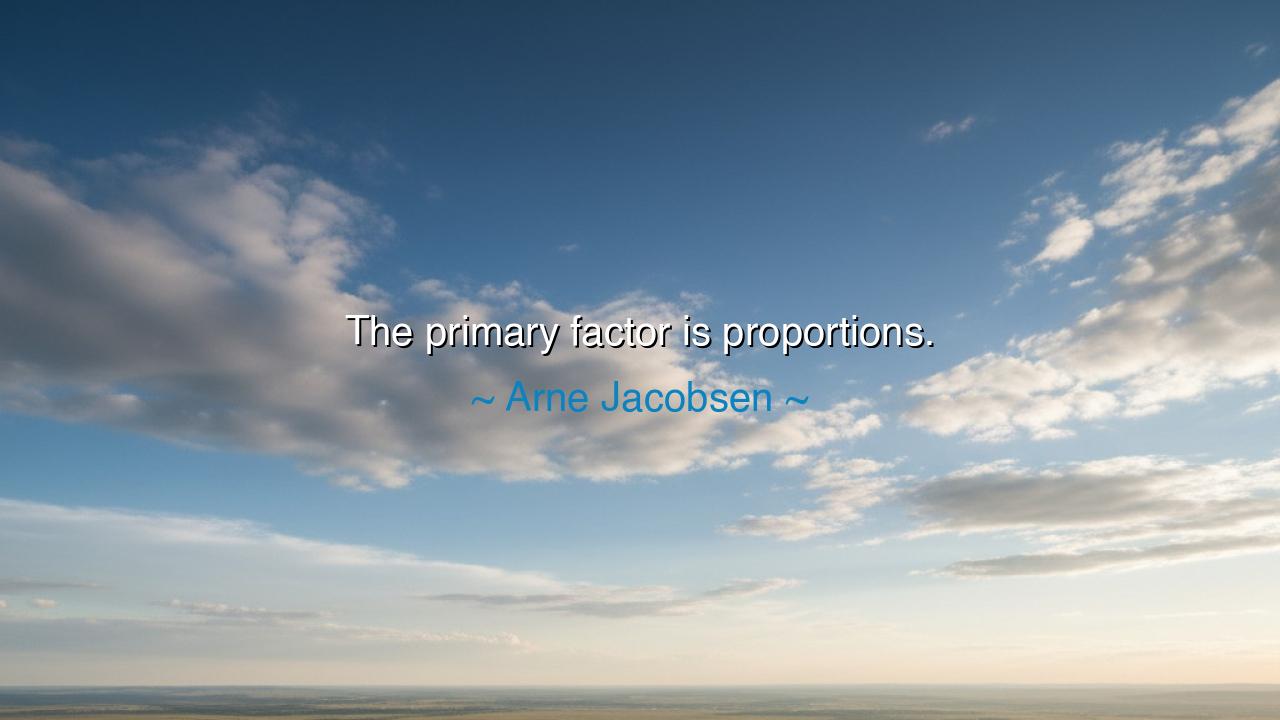
The primary factor is proportions.






The Danish architect and designer Arne Jacobsen, whose creations blended grace with precision, once said: “The primary factor is proportions.” In this brief but eternal statement, he revealed one of the great truths of art, architecture, and indeed of life itself — that harmony, not excess, is the foundation of all beauty. For proportion is the silent law that governs the universe: the balance of earth and sky, of shadow and light, of form and emptiness. It is what gives structure to chaos and poetry to simplicity. To understand proportion, Jacobsen reminds us, is to understand the secret rhythm by which all things endure.
To grasp the meaning of his words, we must first see who Jacobsen was — a man of quiet conviction, who shaped modern design not through grandeur, but through balance. In his buildings and furniture — from the Egg Chair to the SAS Royal Hotel in Copenhagen — he sought not spectacle but serenity. Every curve, every line, every space was measured not by fashion, but by feeling. He believed that when all elements of a design stand in correct relation to one another, the result transcends time and culture. That is the power of proportion — it makes the temporary eternal, the practical divine.
The ancients, too, knew this truth. The Greek sculptor Polykleitos wrote of the Canon, a set of perfect ratios for the human form, where every limb and line existed in harmonious relation to the whole. His statue of the Doryphoros, or “Spear Bearer,” was not praised for ornament but for balance — a body poised between rest and motion, strength and grace. Centuries later, the architect Vitruvius echoed this law in his writings, and Leonardo da Vinci embodied it in his Vitruvian Man. In all their works, the principle was the same: beauty is not abundance, but equilibrium. Proportion is the geometry of truth.
In Arne Jacobsen’s world, proportion was not just a mathematical concept, but a moral one. To design without proportion is to act without restraint, to speak without listening, to live without consideration. He saw the architect as a mediator between chaos and order, between the needs of man and the laws of nature. A building too large for its surroundings, a chair that ignores the comfort of the human form — these, to him, were not merely aesthetic errors, but moral failings. For true design must respect the scale of life itself. It must serve both the eye and the soul, fitting seamlessly into the rhythm of existence.
Consider his SAS Royal Hotel, completed in 1960 — the world’s first “designer hotel.” Every detail, from the structure’s vertical rhythm to the placement of the silverware, reflected Jacobsen’s devotion to proportion. The building stood as a hymn to balance: tall yet light, modern yet humane, functional yet beautiful. It did not seek to dominate the city but to harmonize with it — a quiet dialogue between structure and sky. Critics of the time, blind to subtlety, dismissed it as too simple. Yet decades later, its design is revered as timeless. For what is created in proper proportion never fades; it remains alive, long after the fashions of its age have turned to dust.
But Jacobsen’s words reach beyond design; they speak to all who seek to live wisely. In life as in architecture, proportion is the measure of wisdom — the balance between work and rest, ambition and humility, speech and silence, giving and receiving. A life out of proportion, like a building built without balance, soon collapses under its own weight. To live well, one must learn the art of measure: to know when enough is enough, when beauty becomes excess, when action becomes noise. In this sense, the architect and the philosopher share the same task — to build harmony out of disorder.
Thus, my listener of the future, let Arne Jacobsen’s words be your guide. In all that you create — be it a home, a relationship, or a dream — seek proportion. Let your choices fit the contours of your soul as his designs fit the human hand. Remember that the greatness of a thing lies not in its size, but in its balance. The mountain and the pebble alike obey the same laws of proportion, and both are perfect in their place.
For in the end, proportion is not merely a principle of design; it is the rhythm of life itself. It is the harmony between reason and emotion, between humanity and nature, between what is and what ought to be. To live with proportion is to live in peace — and to design with proportion is to leave behind something eternal. So let every act of creation, and every act of living, begin with this sacred truth: “The primary factor is proportions.”






AAdministratorAdministrator
Welcome, honored guests. Please leave a comment, we will respond soon